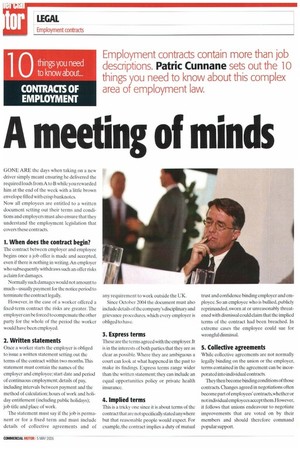A meeting of minds
Page 40

If you've noticed an error in this article please click here to report it so we can fix it.
GONE ARE the days when taking on a new driver simply meant ensuring he delivered the required loads from A to B while you rewarded him at the end of the week with a little brown envelope filled with crisp banknotes.
Now all employees are entitled to a written document setting out their terms and conditions and employers must also ensure that they understand the employment legislation that covers these contracts.
1. When does the contract begin?
The contract between employer and employee begins once a job offer is made and accepted, even if there is nothing in writing. An employer who subsequently withdraws such an offer risks a claim for damages.
Normally such damages would not amount to much— usually payment for the notice period to terminate the contract legally.
However, in the case of a worker offered a fixed-term contract the risks are greater. The employer can be forced to compensate the other party for the whole of the period the worker would have been employed.
2. Written statements
Once a worker starts the employer is obliged to issue a written statement setting out the terms of the contract within two months. This statement must contain the names of the employer and employee; start date and period of continuous employment; details of pay, including intervals between payment and the method of calculation; hours of work and holiday entitlement (including public holidays); job title and place of work.
The statement must say if the job is permanent or for a fixed term and must include details of collective agreements and of any requirement to work outside the UK.
Since October 2004 the document must also include details of the company's disciplinary and grievance procedures, which every employer is obliged to have.
3. Express terms
These are the terms agreed with the employer. It is in the interests of both parties that they are as clear as possible. Where they are ambiguous a court can look at what happened in the past to make its findings. Express terms range wider than the written statement; they can include an equal opportunities policy or private health insurance.
4. Implied terms
This is a tricky one since it is about terms of the contract that are not specifically stated anywhere but that reasonable people would expect. For example, the contract implies a duty of mutual trust and confidence binding employer and employee. So an employee who is bullied, publicly reprimanded, sworn at or unreasonably threatened with dismissal could claim that the implied terms of the contract had been breached. In extreme cases the employee could sue for wrongful dismissal.
5. Colledive agreements
While collective agreements are not normally legally binding on the union or the employer, terms contained in the agreement can be incorporated into individual contracts.
They then become binding conditions of those contracts. Changes agreed in negotiations often become part of employees' contracts,whetheror not individual employees acceptthetn.However, it follows that unions endeavour to negotiate improvements that are voted on by their members and should therefore command popular support.






































































































































































































